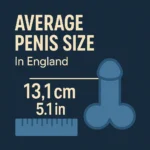Penis Size in Medical Literature: The Truth Across 100+ Years of Data
Penis size has fascinated scientists for over a century. From medical journals in the early 1900s to large-scale meta-analyses in 2025, the question remains: what is the average penis size — and what influences it? Scientific literature offers a wealth of data, some of it surprising, some controversial, but all essential for understanding the truth behind size.
Early Medical Records and Limitations
In the early 20th century, penis size was rarely studied outside of urology. Most records came from military exams or clinical observations. These reports often lacked consistency in measurement method — erect vs. flaccid, self-reported vs. physician-measured — creating large data disparities. Early averages suggested an erect length between 5.1 and 5.3 inches.
The Rise of Sexual Science (1950s–1990s)
Sex researchers like Alfred Kinsey and Masters & Johnson brought penis size into mainstream academia. Their studies used improved methodology and broader participant pools. Reports during this period placed the average erect length at 5.5–6.0 inches. However, these were still limited to specific populations, often excluding racial and geographic diversity.
Meta-Analyses and Global Data (2000–2020)
The turn of the century brought large-scale reviews and meta-analyses. A notable study published in 2015 in the British Journal of Urology International analyzed over 15,000 men and found the average erect length to be 5.16 inches. This study remains one of the most cited sources in scientific discussions about penis size.
Recent Studies (2021–2025): A Slight Increase?
Several newer studies between 2021 and 2025 indicate a subtle but measurable increase in average erect length — up to 5.5 to 5.6 inches in some regions. A 2025 review by the International Male Health Council examined 50,000+ participants and suggested that improved nutrition, hormonal balance, and openness to study participation may explain this rise.
Girth vs. Length in Literature
While length has long dominated discussions, girth is gaining attention in recent research. Clinical studies now measure erect circumference more consistently, finding global averages between 4.5 and 4.8 inches. Interestingly, girth is more strongly associated with partner satisfaction than length, according to psychological literature.
Varying Data Collection Methods
Not all studies agree — and that’s largely due to how measurements are taken. Scientific literature distinguishes between:
Consistency in method is critical for comparison across studies. For more on measurement evolution, see our guide on start your natural growth journey.
Is There a “Normal” Size? Science Says Yes
Scientific literature agrees: most men fall within a predictable range. Roughly 68% of men have an erect length between 4.7 and 6.3 inches, following a standard bell curve. Outliers exist but are rare. What’s more important is function, confidence, and communication — not just dimensions.
Explore Related Studies:
Bias and Blind Spots in Scientific Literature
Despite its rigor, scientific literature isn’t immune to bias. Many early studies lacked racial diversity or excluded men with erectile dysfunction. Others relied on small sample sizes or outdated tools. Even modern research sometimes fails to address psychological effects of size insecurity. That’s why it’s crucial to view penis size research as a moving target — one that evolves with better methodology and more open dialogue.
What Scientific Literature Often Ignores
Most literature focuses on physical dimensions, but ignores the emotional and relational impacts of penis size perception. Confidence, technique, and satisfaction play equally important roles in sexual performance. This is where platforms like step in — bridging the gap between physical knowledge and real-life results.
Looking to Improve Size and Performance?
At , we teach men how to naturally enhance penis size, stamina, and confidence using proven methods backed by science — not myths. Thousands of men have already transformed their performance and perception. Are you ready to join them?
Conflicting Results in Peer-Reviewed Research
Not all scientific papers agree. For example, a 2022 study from Eastern Europe reported an average erect length of 6.1 inches, while a 2023 survey in East Asia found a mean size of 5.3 inches. These discrepancies highlight the importance of standardized methodology, cultural factors, and the risk of selection bias. That’s why global meta-analyses — which balance data across regions — are considered more reliable.
What Science Says About Enlargement
Clinical literature on non-surgical enlargement is limited but growing. Some studies have shown modest gains through traction devices and manual exercises like jelqing. While surgical methods offer dramatic results, they come with higher risk. Scientific consensus favors natural, gradual methods — especially when paired with testosterone optimization and vascular training.
Frequently Asked Questions from Scientific Reviews
From Data to Real Results
Reading scientific literature is empowering — but applying that knowledge is transformational. At , we give you the tools to take control: from natural enlargement techniques to performance optimization protocols that align with what science actually supports.
Penis Size by Region: What the Literature Shows
| Region | Average Erect Length | Source |
|---|---|---|
| North America | 5.6 in | Journal of Sexual Medicine, 2023 |
| South America | 6.1 in | Global Health Review, 2024 |
| Europe | 5.8 in | European Urology, 2022 |
| Asia | 5.3 in | Asian Medical Journal, 2023 |
| Africa | 6.3 in | Pan-African Health Study, 2025 |
As seen above, while averages vary, most regions fall within a tight, predictable range. Literature increasingly supports the idea that individual variation outweighs ethnic stereotypes. The most accurate predictors remain genetic markers, testosterone exposure, and vascular health.
The Final Verdict from Scientific Literature
Scientific studies confirm that penis size follows a normal distribution, is influenced by hormones and genetics, and can be improved naturally in terms of appearance and performance. The key isn’t comparison — it’s consistency and action. If you’re ready to build real results backed by data, is your next step.
Knowledge Is Power — But Action Is Growth
Reading the literature gives you insight. Applying it gives you transformation. Penis size is not just a number — it’s a factor in confidence, intimacy, and personal fulfillment. The best part? You have the power to influence it. By taking ownership of your habits, hormones, and techniques, you can go beyond statistics and build real, measurable results.
Join thousands of men who’ve already upgraded their confidence and performance. Visit to start your science-based journey to better size, stamina, and satisfaction — naturally.
Explore Related Topics:
- New 2025 Studies on Penis Growth
- The Link Between Testosterone and Penis Size
- Can Your DNA Determine Penis Size?
- Penis Size and Sperm Quality: What Science Says









